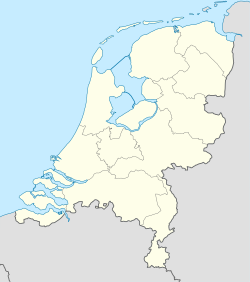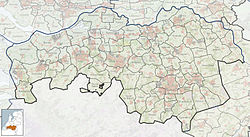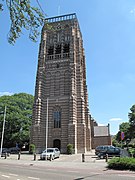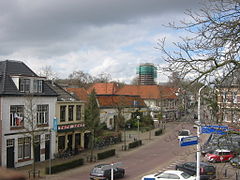
's-Hertogenbosch, colloquially known as Den Bosch, is a city and municipality in the Netherlands with a population of 160,783. It is the capital of the province of North Brabant and its fourth largest city by population. The city is south of the Maas river and near the Waal.

North Brabant, also unofficially called Brabant, is a province in the south of the Netherlands. It borders the provinces of South Holland and Gelderland to the north, Limburg to the east, Zeeland to the west, and the Flemish provinces of Antwerp and Limburg to the south. The northern border follows the Meuse westward to its mouth in the Hollands Diep strait, part of the Rhine–Meuse–Scheldt delta. North Brabant had a population of about 2,626,000 as of January 2023. Major cities in North Brabant are Eindhoven, Tilburg, Breda, its provincial capital 's-Hertogenbosch, and Helmond

Camp Westerbork, also known as Westerbork transit camp, was a Nazi transit camp in the province of Drenthe in the Northeastern Netherlands, during World War II. It was located in the municipality of Westerbork, current-day Midden-Drenthe. Camp Westerbork was used as a staging location for sending Jews, Sinti and Roma to concentration camps elsewhere.

Amersfoort is a city and municipality in the province of Utrecht, Netherlands. As of 31 January 2023, the municipality had a population of 160,902, making it the second-largest of the province and fifteenth-largest of the country. Amersfoort is also one of the largest Dutch railway junctions with its three stations—Amersfoort Centraal, Schothorst and Vathorst—due to its location on two of the Netherlands' main east to west and north to south railway lines. The city was used during the 1928 Summer Olympics as a venue for the modern pentathlon events. Amersfoort marked its 750th anniversary as a city in 2009.

Roosendaal is both a city and a municipality in the southern Netherlands, in the province of North Brabant.

Haaren is a town and former municipality in the southern Netherlands, in the province of North Brabant.

Sint-Michielsgestel is a municipality in the southern part of the Netherlands. It is named for the village of Sint-Michielsgestel located within its boundaries.

Drechterland is a municipality in the Netherlands, in the province of North Holland and the region of West-Frisia. The municipality was formed in 1979, in a merger of the former municipalities of Hoogkarspel, Westwoud and Oosterblokker. Its original name, Bangert, was changed to "Drechterland" in 1980. In 2006, the former municipality of Venhuizen was added to Drechterland.

Kamp Amersfoort was a Nazi concentration camp near the city of Amersfoort, the Netherlands. The official name was "Polizeiliches Durchgangslager Amersfoort", P.D.A. or Amersfoort Police Transit Camp. 37,000 prisoners were held there between 1941 and 1945. The camp was situated in the northern part of the municipality of Leusden, on the municipal boundary between Leusden and Amersfoort in the central Netherlands.

Herzogenbusch was a Nazi concentration camp located in Vught near the city of 's-Hertogenbosch, Netherlands. The camp was opened in 1943 and held 31,000 prisoners. 749 prisoners died in the camp, and the others were transferred to other camps shortly before Herzogenbusch was liberated by the Allied Forces in 1944. After the war, the camp was used as a prison for Germans and for Dutch collaborators. Today there is a visitors' center which includes exhibitions and a memorial remembering the camp and its victims.
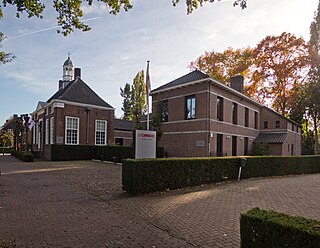
Helvoirt is a village and part of the municipality of Vught, Netherlands.

Johann Baptist Albin Rauter was a high-ranking Austrian-born SS functionary and war criminal during the Nazi era. He was the highest SS and Police Leader in the occupied Netherlands and therefore the leading security and police officer there during the period of 1940–1945. Rauter reported directly to the Nazi SS chief, Heinrich Himmler, and also to the Nazi governor of the Netherlands, Arthur Seyss-Inquart. After World War II, he was convicted in the Netherlands of crimes against humanity and executed by firing squad.
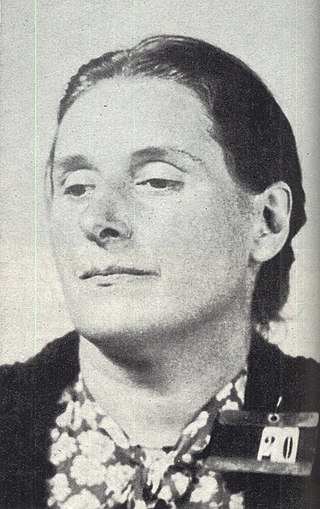
Adrienne Minette (Mies) Boissevain-van Lennep was a Dutch feminist who was active in the Resistance before being arrested by the Nazis and sent to the Herzogenbusch concentration camp. After the war, she promoted the idea of the national liberation skirt, and some of these unusual skirts are now in Dutch museums.

Nieuw Vosseveld is a prison in Vught, Netherlands, part of the Custodial Institutions Agency of the Ministry of Justice and Security within the Dutch criminal justice system. Penitentiaire Inrichting Vught is now the general term used instead of Nieuw Vosseveld. Part of Nieuw Vosseveld is a maximum security prison; it holds some of Europe's most dangerous criminals, including Hüseyin Baybaşin, Mohammed Bouyeri and Ridouan Taghi.
The following is a timeline of the history of the municipality of 's-Hertogenbosch, Netherlands.

Franciscus Max "Franc" Weerwind is a Dutch politician of Democrats 66 (D66) who served as minister for legal protection in the cabinet of Prime Minister Mark Rutte from January 2022 until July 2024.
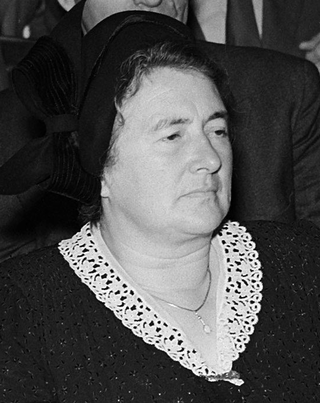
Geertruida Catharina Theresia Maria "Truus" Smulders-Beliën was a Dutch politician and teacher who was the mayor of Oost-, West- en Middelbeers in North Brabant from 1946 to 1966. The first female mayor in the Netherlands, she succeeded her husband Jan Smulders after he was executed by Nazi soldiers.

Helena Theodora Kuipers-Rietberg was a Dutch resistance member who played an important role during World War II, when she was one of the driving forces of a national underground organization that supported those who were hiding from the German occupying forces. She was known as "Tante Riek", or "Aunt Riek".

Dijk en Waard is a municipality in the province of North Holland and the region of West-Frisia, the Netherlands. It was formed from the merger of Heerhugowaard and Langedijk on 1 January 2022.

Johann Friedrich (Hans) Stöver was a German camp commander.




